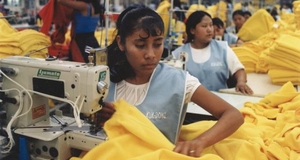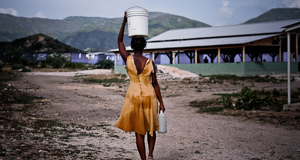|
From Discussions VOL. 11 NO. 1 The Remittance Effect: Do Remittances Help Development?
Remittances do not lead to development if we take, in Amartya Sen’s words, a “foundational view of development” (Sen, 1999, p.5) that moves away from defining development as economic growth and instead foregrounds people’s capabilities, welfare and quality of life.
Micro-level studies of remittance workers and their families show that a rise in income does not necessarily lead to human welfare. In fact, it may instead lock in existing gender and family inequalities. Madeline Wong identified “intrafamily politics around remittances” with respect to female Ghanian remittance workers (Wong, 2006, p.368). Taking into consideration the culturally entrenched obligations of motherhood, she documented the stress and constant unhappiness Ghanian woman remittance workers experienced — a factor in ‘development’ that “the literature often fails to recognize.” Similarly, Vogel and Korinek used household surveys in Nepal to show that, although remittances result in a higher propensity to invest in education, the investment is disproportionately spent in boys’ education, particularly in low-income households relying on male remitters (Vogel and Korinek, 2012, p. 87). In both cases, although there is a rise in income and an investment in human capital, this investment is not happening on an equitable basis.7 If the definition of development is extended to foreground quality of life (not merely GDP growth), then remittances do not necessarily lead to development but rather lock in existing socio-cultural inequalities.
Furthermore, the tendency of remittance studies to take households, not individuals, as their unit of analysis adds to this problem by conflating people’s welfare with household welfare. Researchers are most inclined to examine remittances in households such that a resulting increase in household consumption and investment is taken to be a right step towards development. These studies tend to overlook the inequality and power dynamics within households. Leisy Abrego, for example, points out that mothers are expected to willingly self-sacrifice, and that female workers tend to send a high percentage of remittances, even when they earn meager wages (Abrego, 2009, p.1078). Indeed, Vogel and Korinek point out something that remittance-optimists hardly take into account: “the family is also a gendered institution” (Vogel and Korinek, 2012, p.70). Locating the remittanceand- development nexus in the household, albeit useful and efficient, comes at the expense of conflating an increase in household consumptions and savings as an increase in every family member’s welfare. Therfore, one should consider whether remittances might be institutionalizing or even exacerbating existing inequalities in the household.
Although remittances bring economic potential, policy makers need to not only take a careful look at the methodological shortcomings of research, but also place the results in a political economy and socio-cultural context. The lack of remittance data and omission of sociocultural characteristics of migrants shows an unrealistically positive picture of the impact of remittances on household consumption, investment, and poverty reduction. Sourcedestination dyads between countries means that geography and bilateral relations matter for the volume and impact of remittances. Although the countercyclical nature of remittances is perceived to be mostly positive, in reality, it can create a public moral hazard problem whereby governments shirk their public responsibilities. Futhermore, remittances can exacerbate existing inequalities rather than ameliorate them, which can be seen in gender inequality within households.
Hence, policy makers must carefully consider how ‘development’ is conceptualized and under what circumstances remittances can have negative effects on human welfare, government responsibility, and economic growth. Policy makers need to be cognizant of how these capital flows interact with particular socio-cultural and political factors. Despite the claims of remittance optimists, remittances have a more complex and sometimes harmful effect on development. This less-than-optimistic conclusion is more pragmatic for the development policies of those low-income countries that rely on remittances the most.
Sabrina Singh studies at Swarthmore College. She will graduate in 2015 with an honors major in Political Science and an honors minor in Anthropology. She was born and raised in Kathmandu, Nepal. Academically, she is interested in globalization, international law and development, human rights, and gender and sexuality. Professionally, she has worked as a research fellow for a member of parliament in Nepal and intered at Amnesty International USA. She also enjoys working as a Writing Associate at her college’s writing center.
Abrego, L. (2008). Economic well-being in Salvadorian transnational families: How gender affects remittance practices. Journal of Marriage and Family, 71(4). doi: 10.1111/j.1741-3737.2009.00653.x
Adams, R. H. (n.d.). Remittances, Poverty, and Investment in Guatemala.
Chami, R., Barajas, A., & Cosimano, T. (2008). Macroeconomic consequences of remittances (Publication). International Monetary Fund.
Grabel, I. (2009). Remittances: Political economy and development implications. International Journal of Political Economy.
Impact of remittances in poverty in developing countries (Rep.). (n.d.). United Nations.
Kapur, D. (2003). Remittances: The new development mantra (Tech.).
Migrants from developing countries to send home $414 billion in earnings in 2013. (2013, October 2). The World Bank.
Nallari, R., & Griffith, B. (2011). Understanding growth and poverty: Theory, policy, and empirics. Washington, D.C.: World Bank.
Orozco, M. (2013). Migrant remittances and development in the global economy. Lynne Reinner.
Ratha, D., & Mohapatra, S. (2007). Increasing the macroeconomic impact of remittances on development (Issue brief). Migration Policy Institute.
Ratha, D. (2007). Leveraging remittances for development (Issue brief). Migration Policy Institute.
Sachs, J. (2005). The end of poverty: Economic possibilities for our time. New York: Penguin Press.
Sen, A. (1999). Development as freedom. New York: Knopf.
Vogel, A., & Korinek, K. (n.d.). Passing by the girls? Remittance allocation for educational expenditures and social inequality in Nepal’s households. International Migration Review.
Wong, M. (2006). The gendered politics of remittances in Ghanian transnational families. Economic Geography, 82(4).
Zaman, H., & Akbar, M. I. (n.d.). Progress in development studies (Rep.).
- This paper uses the definition of ‘remittances’ that the World Bank uses: namely, monies comprising of workers’ remittances, migrant transfers and compensation of employees. “Migrant transfers” arise from change of residence for at least one year and “compensation of employees” are funds sent back by temporary workers. See Devesh Kapur, “Remittances: The New Development Mantra,” pg. 2.
- For Sachs, poverty trap is the mechanism due to which the poorest of the world are unable to lift themselves out of poverty. A person in the poverty trap has to use all of his/her income to merely survive, and thus is unable to save, invest, or develop human capital. Jeffrey Sachs, The End of Poverty (New York: Penguin Press, 2005), pg. 56.
- Sachs also includes geography as a key factor in development. He argues that poor countries are poor often because of a geography curse. Remittances, at first, seem to be a balm even to this problem, since migrants are transgressing geographical constraints to send money home. However, most remittances received by developing countries go to lower middle-income countries. Regions like Latin America and South Asia get a significantly larger volume of remittances than Africa despite its large rate of migration. See Devesh Kapur, "Remittances: The New Development Mantra," pg. 10.
- Squared poverty gap is the square of the distance of the poor from the poverty line; as such, it measures the severity of poverty. See Richard H. Adams, Jr., "Remittances, Poverty, and Investment in Guatemala," pg. 68.
- Poverty headcount is the proportion of the population that is counted as poor. Poverty gap index is the total cost of bringing each poor member of a society up to the poverty line. See Raj Nallari and Breda Griffith, Understanding Growth and Poverty: Theory, Policy, and Empirics ( Washington, D.C.: World Bank, 2011), pg. 23.
- In fact, almost half of all remittances received by developing counties go to lowermiddle income countries (like Guatemala). See Devesh Kapur, "Remittances: The New Development Mantra," pg. 8. Hence, although Adams and Page found poverty reduction in terms of poverty gap and squared poverty gap, this might be reflecting a reduction of poverty in low middle income countries or those that are just below the poverty line.
- Plus, gender is not the only social factor: Devesh Kapur (2004) notes that remittances to Cuba have a strong racial bias since the Cuban diaspora is mostly white, while the island is majority black. See Devesh Kapur, "Remittances: The New Development Mantra," pg. 21.
Abrego, L. (2008). Economic well-being in Salvadorian transnational families: How gender affects remittance practices. Journal of Marriage and Family, 71(4). doi: 10.1111/j.1741-3737.2009.00653.x
Adams, R. H. (n.d.). Remittances, Poverty, and Investment in Guatemala.
Chami, R., Barajas, A., & Cosimano, T. (2008). Macroeconomic consequences of remittances (Publication). International Monetary Fund.
Grabel, I. (2009). Remittances: Political economy and development implications. International Journal of Political Economy.
Impact of remittances in poverty in developing countries (Rep.). (n.d.). United Nations.
Kapur, D. (2003). Remittances: The new development mantra (Tech.).
Migrants from developing countries to send home $414 billion in earnings in 2013. (2013, October 2). The World Bank.
Nallari, R., & Griffith, B. (2011). Understanding growth and poverty: Theory, policy, and empirics. Washington, D.C.: World Bank.
Orozco, M. (2013). Migrant remittances and development in the global economy. Lynne Reinner.
Ratha, D., & Mohapatra, S. (2007). Increasing the macroeconomic impact of remittances on development (Issue brief). Migration Policy Institute.
Ratha, D. (2007). Leveraging remittances for development (Issue brief). Migration Policy Institute.
Sachs, J. (2005). The end of poverty: Economic possibilities for our time. New York: Penguin Press.
Sen, A. (1999). Development as freedom. New York: Knopf.
Vogel, A., & Korinek, K. (n.d.). Passing by the girls? Remittance allocation for educational expenditures and social inequality in Nepal’s households. International Migration Review.
Wong, M. (2006). The gendered politics of remittances in Ghanian transnational families. Economic Geography, 82(4).
Zaman, H., & Akbar, M. I. (n.d.). Progress in development studies (Rep.).
Endnotes
- This paper uses the definition of ‘remittances’ that the World Bank uses: namely, monies comprising of workers’ remittances, migrant transfers and compensation of employees. “Migrant transfers” arise from change of residence for at least one year and “compensation of employees” are funds sent back by temporary workers. See Devesh Kapur, “Remittances: The New Development Mantra,” pg. 2.
- For Sachs, poverty trap is the mechanism due to which the poorest of the world are unable to lift themselves out of poverty. A person in the poverty trap has to use all of his/her income to merely survive, and thus is unable to save, invest, or develop human capital. Jeffrey Sachs, The End of Poverty (New York: Penguin Press, 2005), pg. 56.
- Sachs also includes geography as a key factor in development. He argues that poor countries are poor often because of a geography curse. Remittances, at first, seem to be a balm even to this problem, since migrants are transgressing geographical constraints to send money home. However, most remittances received by developing countries go to lower middle-income countries. Regions like Latin America and South Asia get a significantly larger volume of remittances than Africa despite its large rate of migration. See Devesh Kapur, "Remittances: The New Development Mantra," pg. 10.
- Squared poverty gap is the square of the distance of the poor from the poverty line; as such, it measures the severity of poverty. See Richard H. Adams, Jr., "Remittances, Poverty, and Investment in Guatemala," pg. 68.
- Poverty headcount is the proportion of the population that is counted as poor. Poverty gap index is the total cost of bringing each poor member of a society up to the poverty line. See Raj Nallari and Breda Griffith, Understanding Growth and Poverty: Theory, Policy, and Empirics ( Washington, D.C.: World Bank, 2011), pg. 23.
- In fact, almost half of all remittances received by developing counties go to lowermiddle income countries (like Guatemala). See Devesh Kapur, "Remittances: The New Development Mantra," pg. 8. Hence, although Adams and Page found poverty reduction in terms of poverty gap and squared poverty gap, this might be reflecting a reduction of poverty in low middle income countries or those that are just below the poverty line.
- Plus, gender is not the only social factor: Devesh Kapur (2004) notes that remittances to Cuba have a strong racial bias since the Cuban diaspora is mostly white, while the island is majority black. See Devesh Kapur, "Remittances: The New Development Mantra," pg. 21.
Suggested Reading from Inquiries Journal
Learning to play guitar is painful. For the first months, the coarse steel of the guitar strings shreds the soft skin of the player’s fingertips into a disgusting bloody mess. A reasonable person who does not play... MORE»
We met Scott and Kerstin on different sides of the Atlantic. I met the former in Philadelphia on my way to a convenience store in the early hours of a busy morning when my work schedule benefited from a short coffee break... MORE»
In 2014, the United Nations called for "a truly transformative agenda to follow the Millennium Development Goals." This study applies a critical qualitative discourse and textual analysis to examine the first priority of... MORE»
In response to a growing acknowledgement of the failure of international aid, one school of scholars has identified a lack of aid as the defining crisis in development. From their perspective, aid has failed in driving change not due to inherent flaws, but because developed nations have failed to give enough. This school points... MORE»
Latest in Political Science
2022, Vol. 14 No. 09
This interdisciplinary paper investigates the shortfalls and obstacles to success currently facing the climate movement, examining issues represented by the disconnect between policy and electoral politics, the hypocrisy and blatant indifference... Read Article »
2022, Vol. 14 No. 06
Two of the most prevalent protest movements in recent history were the Black Lives Matter and the #StopTheSteal movements. While there are many differences between the two, one of the most prevalent is their use of violence. Whereas the BLM movement... Read Article »
2022, Vol. 14 No. 05
Strong linkages between autocrats and the military are often seen as a necessary condition for authoritarian regime survival in the face of uprising. The Arab Spring of 2011 supports this contention: the armed forces in Libya and Syria suppressed... Read Article »
2022, Vol. 14 No. 04
During the summer of 2020, two fatal shootings occurred following Black Lives Matter protests. The first event involved Kyle Rittenhouse in Kenosha, Wisconsin, and the second Michael Reinoehl in Portland, Oregon. Two shootings, each committed by... Read Article »
2022, Vol. 14 No. 02
In popular international relations (IR) theory, knowledge production is often dismissed as an objective process between the researcher and the empirical world. This article rejects this notion and contends that the process of knowledge production... Read Article »
2022, Vol. 14 No. 01
This article explores the political relationship between nation-building, ethnicity, and democracy in the context of Ethiopia. It traces Ethiopia's poltical history, explores the consequential role ethnicity has played in the formation of the modern... Read Article »
2022, Vol. 14 No. 01
The study examines the degree to which Xi Jinping has brought about a strategic shift to the Chinese outward investment pattern and how this may present significant political leverage and military advantages for China in the Indian Ocean Region (... Read Article »
|




















